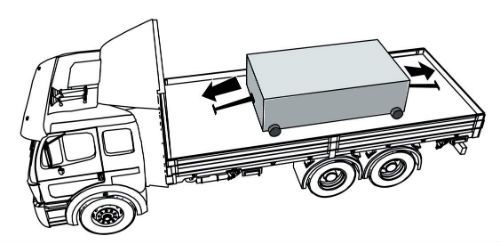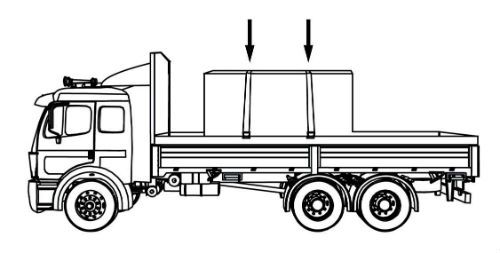CDL Practice Tests: Flatbed Cargo Securement
Choose A Section:
Go!If loading and securing paper rolls on a second layer:
- Lay the second layer horizontally.
- Be sure the bottom layer extends to the front of the vehicle.
- Stack the second layer at the back.
- Make sure heavier rolls are on top.
Stacked Loads
- Load paper rolls on a second layer only if the bottom layer extends to the front of the vehicle.
-
Prevent forward, rearward, or side-to-side movement:
- Either by the same means required for the bottom layer
- Or by the use of a blocking roll from a lower layer.
- A roll in the rearmost row of any layer must not be raised using dunnage.
What is the presumed resistance to horizontal movement of friction mats?
- 100% of cargo weight.
- 0
- 20% of cargo weight.
- 50% of cargo weight.
Note: Friction mats, which are not marked by the manufacturer, are assumed to provide a resistance to horizontal movement equal to 50% of the cargo weight that is resting on the mat.
The definition for "shortwood" identifies pieces that are no longer than:
- Half the length of the trailer.
- 16 ft
- The width of the road.
- 75 in
Shortwood
- Normally up to about 2.5 m (100 in) in length.
- No longer than 4.9 m (16 ft) in length.
-
Also called:
- Cut-up logs
- Cut-to-length logs
- Bolts
- Pulpwood
Which of the following is not a reason why loads should be secured?
- Make it look pretty
- Prevent damage to the cargo
- Avoid fines and citations
- Prevent loss of load
Why secure your load? To prevent:
- Loss of life
- Loss of load
- Damage to the cargo
- Damage to the vehicle
- Issuance of citations/fines to driver/carrier
- The vehicle being placed Out-of-Service.
- A crash
What is the minimum weight of a load of metal coils that requires specific securement practices?
- 2,268 lbs
- 50,000 lbs
- 5,000 lbs
- It depends on the size of the coils.
Size of coil
All metal coil shipments that, individually or together, weigh 2,268 kg (5,000 lb.) or more must be secured according to the specific requirements in this section.
Exception: Metal coils that weigh less than 2,268 kg (5,000 lb.) may be secured according to general securement requirements.
An anchor point is defined as:
- A rail along the side of a vehicle that protects the side of the vehicle from impacts.
- Part of the structure, fitting, or attachment on a vehicle or cargo to which a tiedown is attached.
- A vertical barrier across the front of the deck of a vehicle to prevent forward movement of cargo.
- The load carrying area of a truck, trailer, or intermodal container.
Anchor point:
Part of the structure, fitting, or attachment on a vehicle or cargo to which a tiedown is attached.
Option #1 for securing coils transported with eyes lengthwise includes:
- Attaching at least one tiedown diagonally from the left side of the vehicle, through the eye, to the right side of the vehicle
- Using blocking or friction mats to prevent forward movement.
- Attaching at least one tiedown diagonally from the right side of the vehicle, through the eye, to the left side of the vehicle
- It should include all of these things
Tiedowns, Single Coil Option #1
Attach at least one tiedown diagonally from the left side of the vehicle, through the eye, to the right side of the vehicle. If possible, the angle between the tiedown and the deck should be less than 45, when viewed from the side of the vehicle.
Attach at least one tiedown diagonally from the right side of the vehicle, through the eye, to the left side of the vehicle. If possible, the angle between the tiedown and the deck should be less than 45, when viewed from the side of the vehicle.

Attach at least one tiedown side-to-side over the top of the coil.
Use blocking or friction mats to prevent forward movement.
Which of the following is not a requirement for shortwood loaded lengthwise?
- Each outside log bearing against stakes should extend at least 6 in beyond the stakes at each end.
- Logs should be centered in the bunk.
- Heavier logs must be stacked on top.
- Must be cradled in a bunk or contained by stakes.
Requirements for shortwood loaded lengthwise
- Shortwood must be cradled in a bunk or contained by stakes.
- Logs should be centered in the bunk.
- Each outside log bearing against stakes should extend at least 0.15 m (6 in) beyond the stakes at each end.
The maximum distance from the rear allowed for attaching mechanisms used to secure roll-on/roll-off containers is:
- 3 feet
- 6 1/2 feet
- 2 feet
- It doesn't matter.

Attach mechanisms used to secure the rear end of a roll-on/roll-off or hook lift container no more than two meters (6.5 feet) from the rear of the container.
Concrete pipe loaded crosswise generally:
- All of these things apply.
- At least one tiedown through the rear pipe of the bottom tier must run forward at an angle not more than 45 with the horizontal when viewed from the side of the vehicle, when ever practical.
- Note: At least one tiedown through the front pipe of the bottom tier must run rearward at an angle not more than 45 with the horizontal when viewed from the side of the vehicle, when ever practical.
- Concrete pipe with an inside diameter up to 1.143 m (45 in) can form a complete single tier on a typical flatbed vehicle. Larger pipe often can only be carried as a partial tier.
Special Circumstances: Securing Pipe with an Inside Diameter Up to 1.143 mm (45 in)
Concrete pipe with an inside diameter up to 1.143 m (45 in) can form a complete single tier on a typical flatbed vehicle. Larger pipe often can only be carried as a partial tier.
Note: This pipe diameter of 1.143 m (45 in) is simply a convenient breaking point between "medium" and "large" diameter pipe.
Note: At least one tiedown through the front pipe of the bottom tier must run rearward at an angle not more than 45 with the horizontal when viewed from the side of the vehicle, when ever practical.
At least one tiedown through the rear pipe of the bottom tier must run forward at an angle not more than 45 with the horizontal when viewed from the side of the vehicle, when ever practical.
About The Flatbed Cargo Securement CDL Manual
Studying the flatbed cargo securement CDL manual is not a requirement for getting your CDL permit or license. It is required knowledge for flatbed drivers.
Some questions you should be able to answer for flatbed cargo securement:
- What is the minimum Working Load Limit of a tiedown used to secure logs?
- What is the minimum weight of a shipment of paper rolls that would require specific securement requirements?
- When securing concrete pipe over 45 inches loaded crosswise, which direction must the tiedowns on the front half of the load run?
- What is a cab shield?
- When securing concrete pipe over 45 inches loaded crosswise, which direction must the tiedowns on the rear half of the load run?
- What is a dunnage bag?
- Who is responsible for inspecting securing devices and cargo within the first 50 miles?
- How many tiedowns are required on a stack of shortwood loaded crosswise?
- What is the minimum working load limit of each tiedown used to secure crushed or flattened vehicles?
- Define 'bolster'
- What is a hook-lift container?
- When a tiedown is attached directly to the cargo, what is the ideal angle where it attached to the vehicle?
What is a securing device?
Any device specifically manufactured to attach or secure cargo to a vehicle or trailer:
- Synthetic Webbing
- Chain
- Wire rope
- Manila rope
- Synthetic rope
- Steel strapping
- Clamps and latches
- Blocking
- Front-end structure
- Grab hooks
- Binders
- Shackles
- Winches
- Stake pockets
- D-rings
- Webbing ratchet
- Bracing
- Friction mat
What is a tiedown?
A combination of securing devices that forms an assembly that:
- Attaches cargo to, or restrains cargo on a vehicle.
- Is attached to anchor point(s).

Some tiedowns are attached to the cargo and provide direct resistance to restrain the cargo from movement.

Some tie-downs pass over or through the cargo. They create a downward force that increases the effect of friction between the cargo and the deck. This friction restrains the cargo.
 Related Cargo Securement Terms That Every Driver Should Know:
Related Cargo Securement Terms That Every Driver Should Know:
-
Tiedown:
A combination of securing devices which form an assembly that attaches cargo to, or restrains cargo on, a vehicle or trailer, and is attached to anchor point(s).
-
Contained:
Cargo is contained if it fills a sided vehicle, and every article is in contact with or sufficiently close to a wall or other articles so that it cannot shift or tip if those other articles are also unable to shift or tip.
-
Blocking:
A structure, device, or another substantial article placed against or around an article to prevent horizontal movement of the article.
How should tiedowns be attached?
Tiedowns can be used in two ways:
-
Attached to the cargo:
- Tiedowns attached to the vehicle and attached to the cargo.
- Tiedowns attached to the vehicle, pass through or aroundan article of cargo, and then are attached to the vehicle again.
-
Pass over the cargo:
- Tiedowns attached to the vehicle, passed over the cargo, and then attached to the vehicle again.
Tiedown placement:

Place the tiedown as close as possible to the spacer.
Position the tiedowns as symetrically as possible over the length of the article.

Position the tiedowns to preserve the integrity of the article.







 TT On Facebook
TT On Facebook